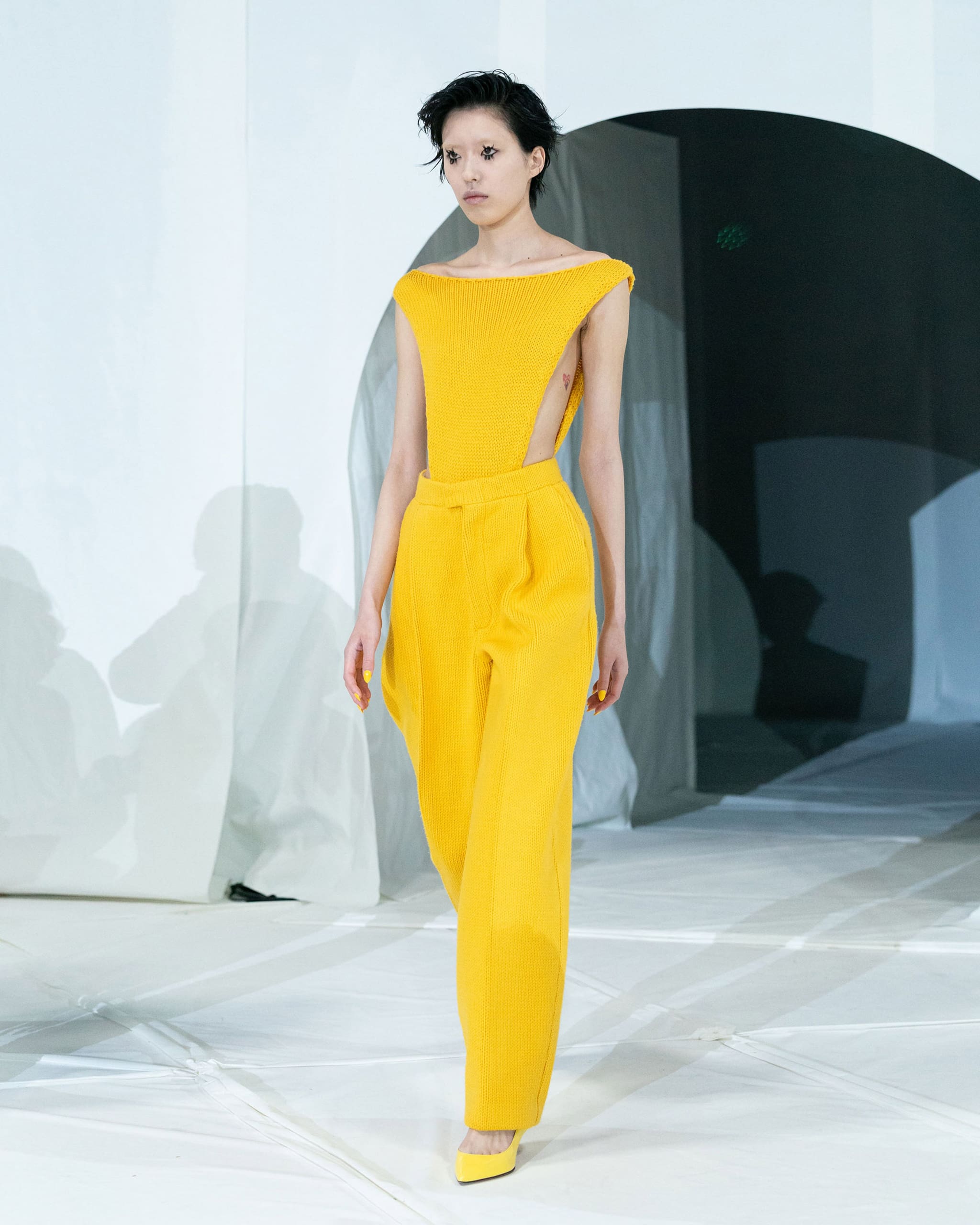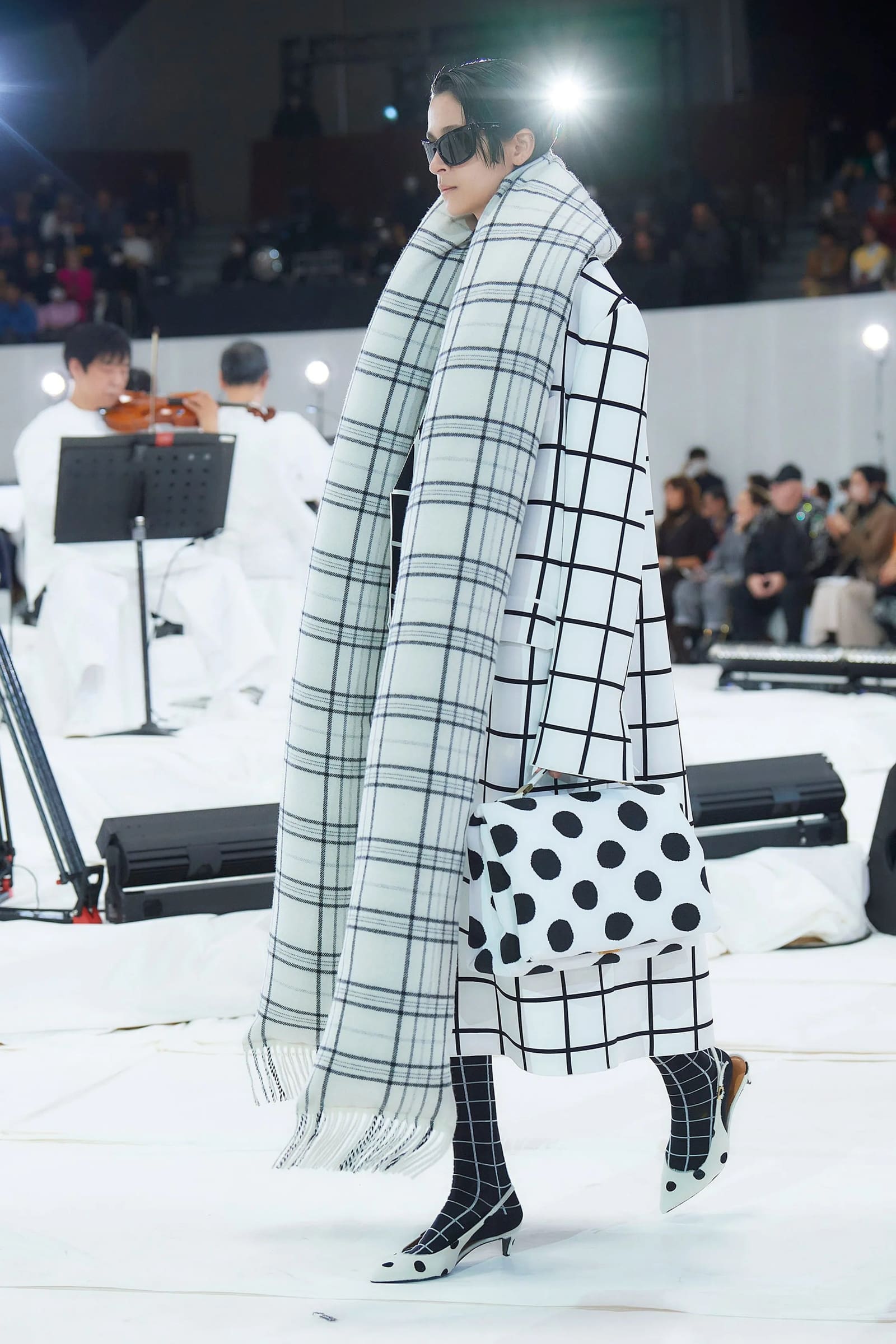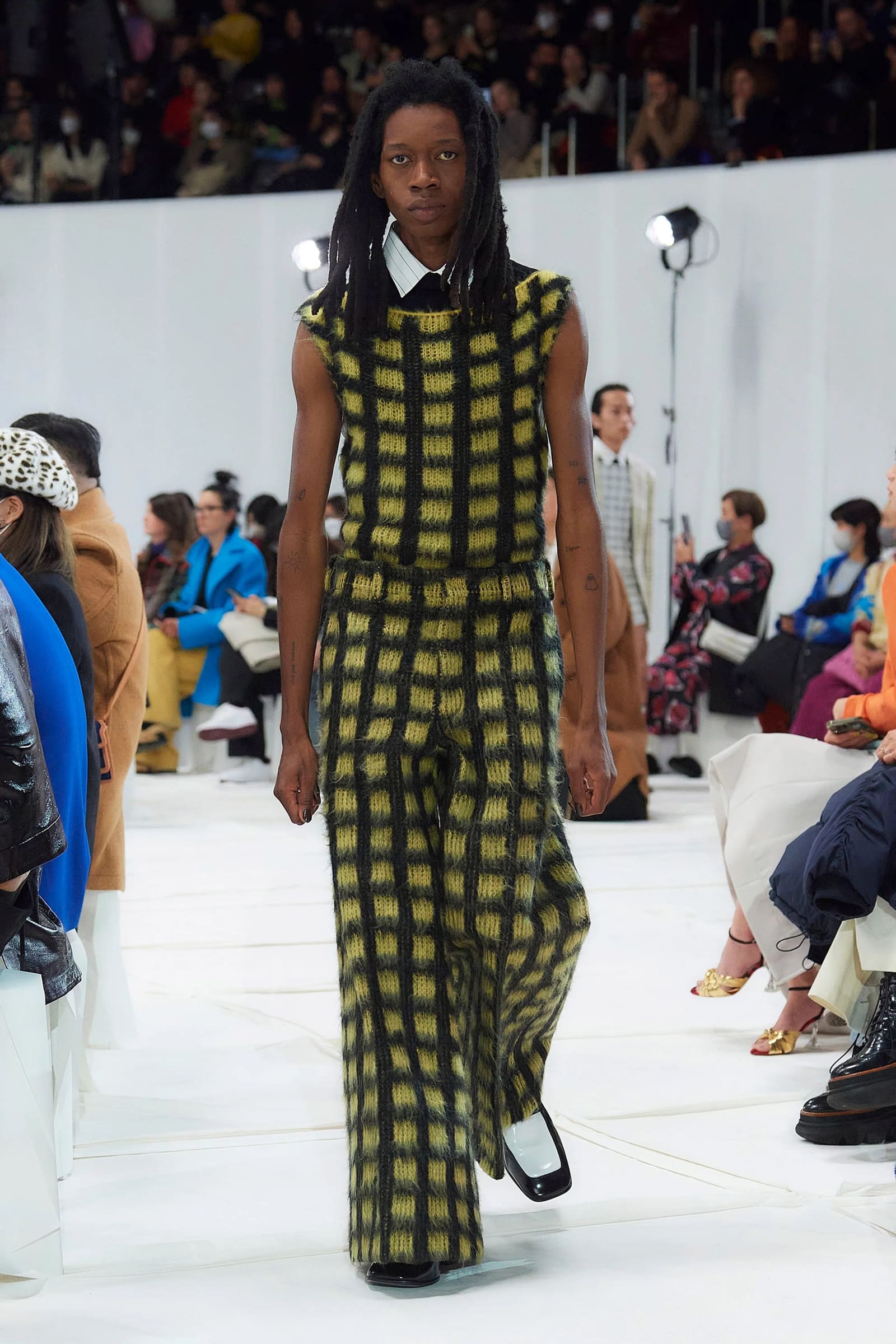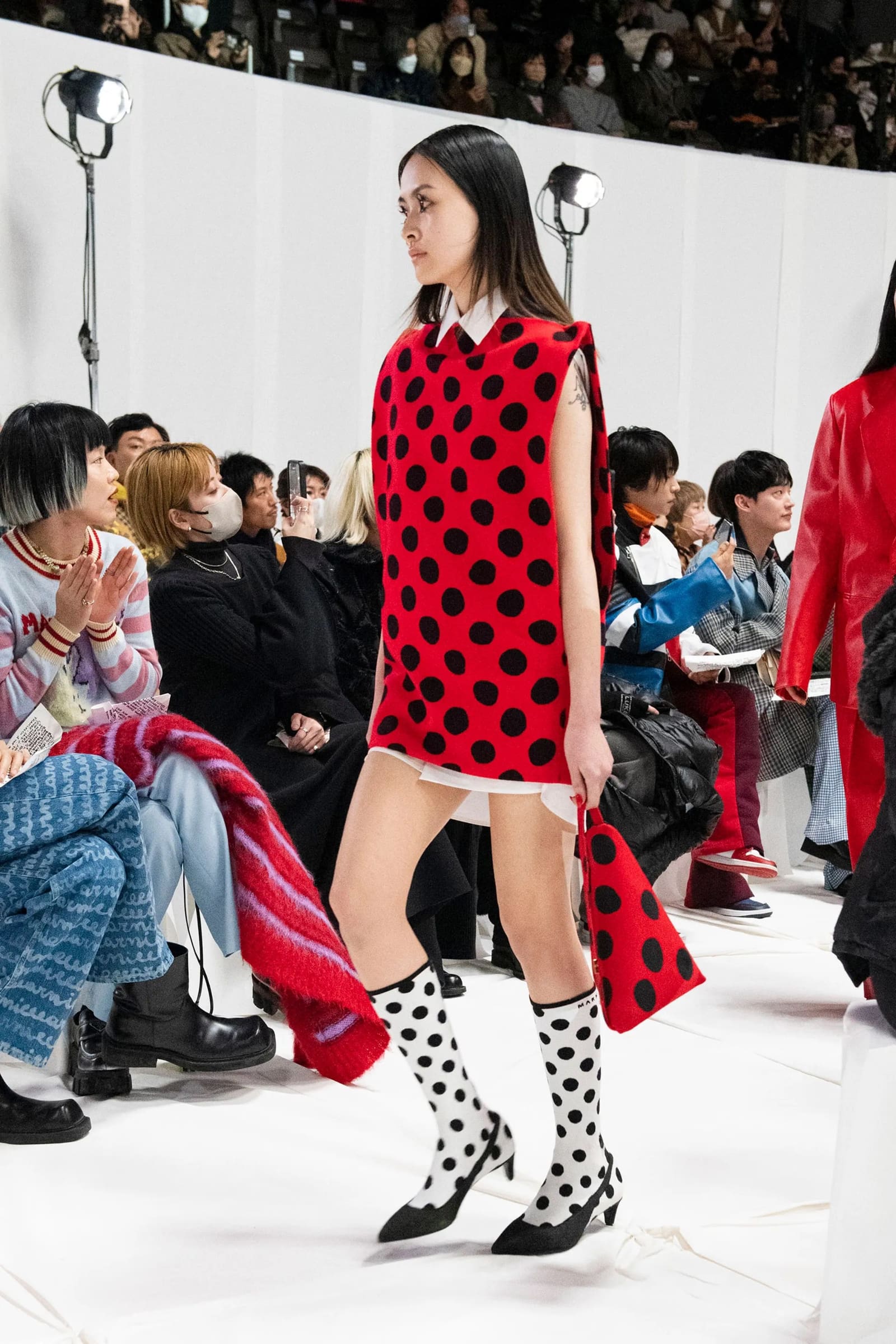
Courtesy of Marni
For fall/winter 2023, Francesco Risso brought Marni to Tokyo—a city that’s inspired him for years. Here, British Vogue’s fashion critic Anders Christian Madsen reports from the front row at the Yoyogi National Gymnasium.
-
 Courtesy of Marni1/5
Courtesy of Marni1/5Marni took its world tour to Tokyo
“I’m done with futile objects. We need to focus on making something that has longevity,” Francesco Risso declared before his co-ed Marni show in Tokyo. Following last season’s relocation to New York, it marked the second stop on what he refers to as the brand’s “tour”: a way for him to connect with the global communities of customers that he says make the clothes he designs come to life. Disenchanted with fashion’s assembly-line mentality—“too much product, too much fashion”—Risso wanted to celebrate and emulate Japanese culture’s respect for permanence. “During the pandemic, we were talking so much about making things better but now it’s worse than before. I came here right after the New York show and I felt this sense of calm. Here, I could breathe. There’s no need for futility. I told my team, we need to make things that mirror the value of our job, which is about patience, practice, and years of experience. Not logo sweatshirts and a statement and your business is done. No! There’s zero longevity in that. The synchronization with Japanese culture is about being inspired by how much sacrifice there is in disciplining, learning, and making. Here, they’re masters of that.”
-
 Courtesy of Marni2/5
Courtesy of Marni2/5The show took place in Yoyogi National Gymnasium
With around 2,000 mostly local guests, the show took place in a Yoyogi National Gymnasium draped in white cloth. Here, the Tokyo Chamber Orchestra climbed a podium with a massive drum in the centre. As the first gong sounded for the show and the models came out, traversing the podium and its surrounding runway, the live violins and cellos interacted with electronic synthesizers in a highly emotive orchestration created by Dev Hynes. “I’ve been studying the cello lately,” Risso said. “It’s something that comes with patience and a lot of studying. It’s extremely inspiring. I was thinking, if I could put that care, that love, that passion, that practice into the objects we make, maybe somebody would get influenced by it.” After the show, a choir of some 100 singers lined the stairways around the circular bleachers of the gymnasium and sang in the finale. It was pretty epic. Risso emerged for his bow wearing the same paper scrubs as the orchestra—an outfit he’d been wearing leading up to the show so everyone he met along his way could scribble on it, personalize it, imbue it with human value.
-
 3/5
3/5The collection was bold and tactile
“I feel an urge to find a way of making something born not to be a futile object—not to be a waste—but which can last in time. In a way, it’s a sense of rigour but not the harsh kind—a rigour that makes us reflect,” Risso said. He translated that rigour into lines that felt, well, more rigorous than the soft, unravelling silhouette many associate with his Marni. The collection was characterised by the bold polka dots, multi-checks and primary colours that painted its surfaces, each hand-worked to a degree that felt both aged and saturated—hyper-personalised, if you will. “First of all, it’s the amount of work we’ve put into each object. We go from beautiful work that we did on our classics—really coating them and purifying them but making them very high-quality—and then I thought, maybe we have to start from a point and a line. That’s how the rhythm came through,” he explained. The tactile textures and graphics covered tailoring silhouettes that had a cartoonish sartorialism about them—especially when expanded into puffer manifestations—and decidedly evening-oriented dresses that played with 1950s and ’60s lines, from peplumed skirts to scanty hemlines.
Advertisement -
 Courtesy of Marni4/5
Courtesy of Marni4/5Francesco Risso made a case for longevity
For Risso, Marni’s world tour is different to the destination shows we associate with resort and spin-off collections. “Marni is very successful in Japan, so doing a show here is not a commercial operation to ‘activate’,” he said, using a marketing word, “but more for me to really be in touch with this world. It’s about changing your dynamic according to where you are. Each city has different rules, its people have different rules.” He first had the epiphany to tour during the pandemic’s DIY-fuelled phygital “Marnifesto” show, for which he sent clothes to people around the world and asked them to model and capture them long-distance. “It was so interesting to allow people to dress themselves, film themselves, change the looks according to where they were. It revealed this need for us to deeply connect with people and make them part of the dialogue.” The objective is to create a more meaningful relationship between product and client. “To me, clothes are living beings. They don’t exist if there’s not a human who puts them on. That relationship to me is the most important.”
-
 Courtesy of Marni5/5
Courtesy of Marni5/5Risso is no stranger to Tokyo
The choice of Tokyo as the second stop on his Marni tour was no tourist decision on Risso’s part. Before the pandemic, he used to come here three to four times a year. “I missed it so much. I have friends here. I want to explore more. Every time I come there’s so many new surprises. It’s a magnificent city but it’s also very hidden. What shocks me every time I get here is the sound: there’s no sound. I mean, the sound is soft. It’s not like New York where you need three days to adapt and scream on top of people in order to hear them. Here, you walk around at the busiest times and there’s this gentle sound. It’s a dream city.” Speaking of silence, Risso frequents the city’s so-called listening rooms, one of which commands its visitors to remain completely silent (“I find it genius!”). After his sound therapy, he goes to lunch at Narukiyo in Shibuya.
This article was originally published on British Vogue.
- Topics:
- Runway